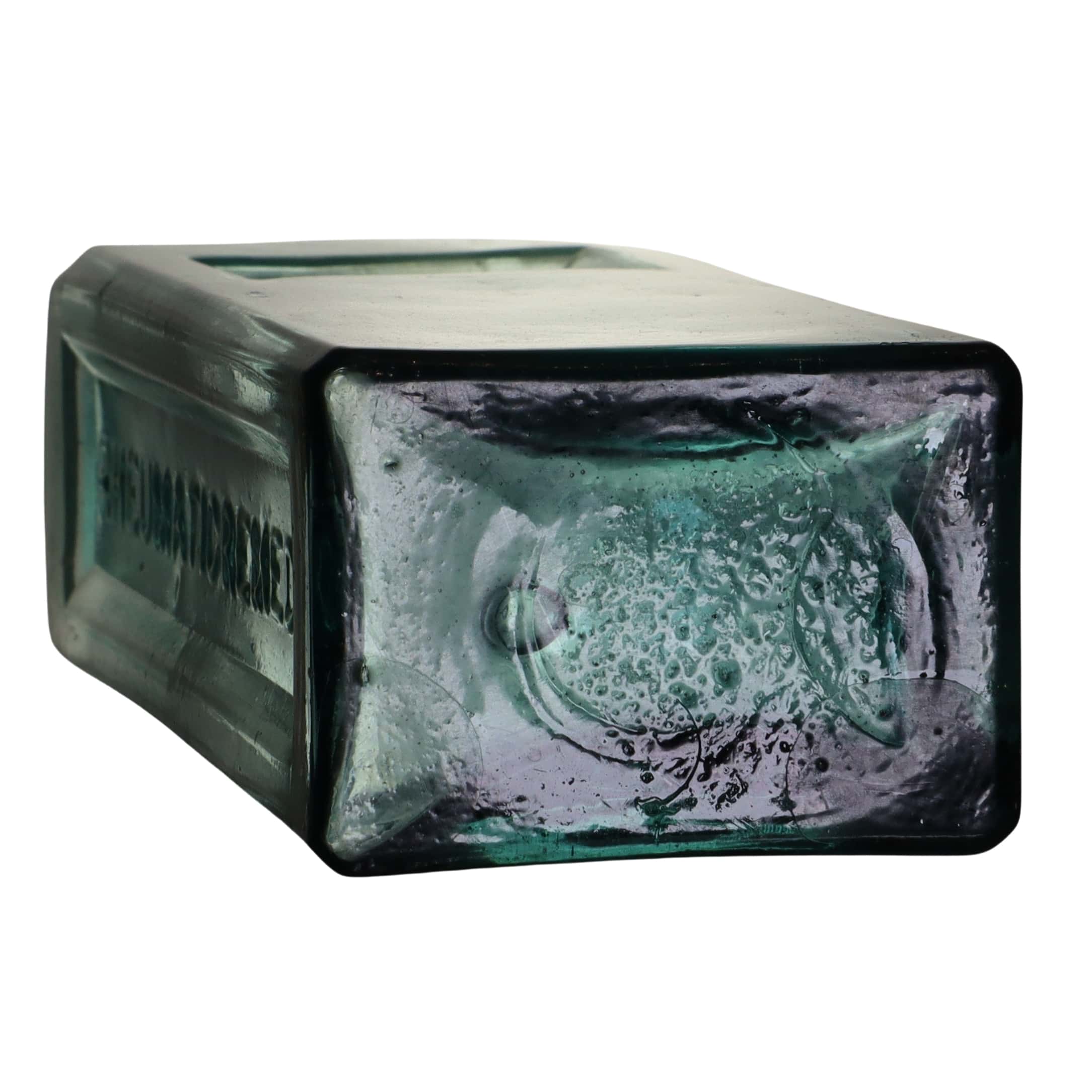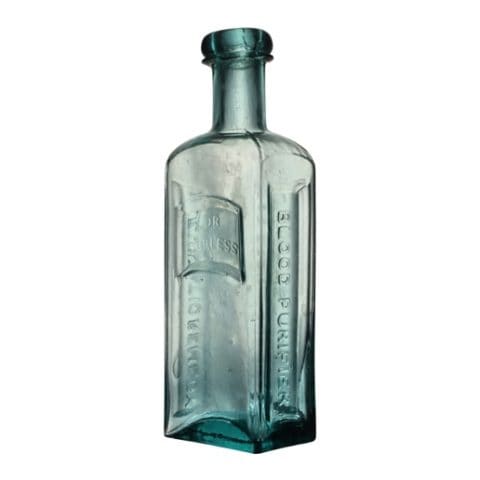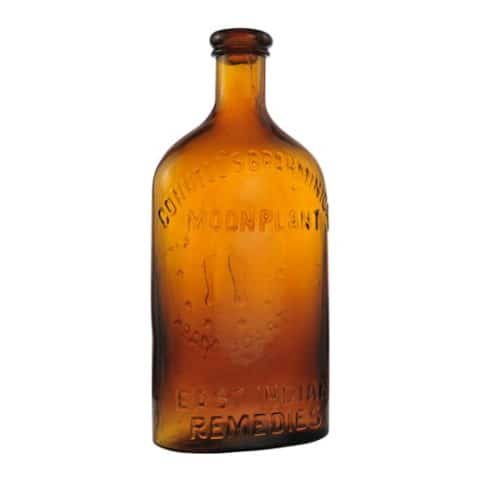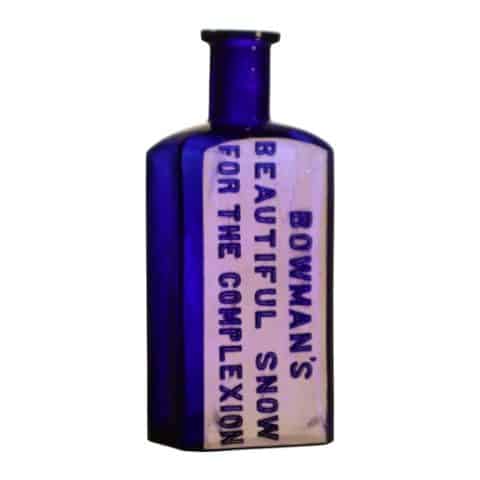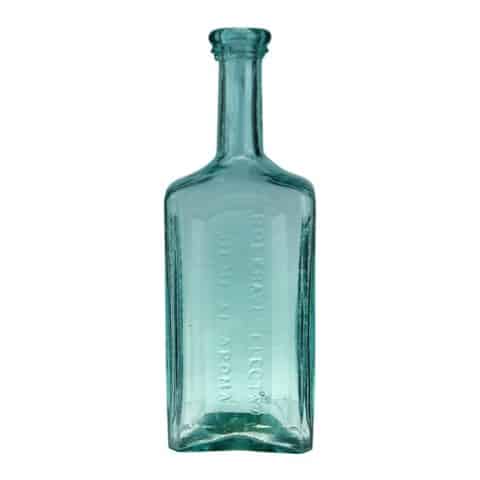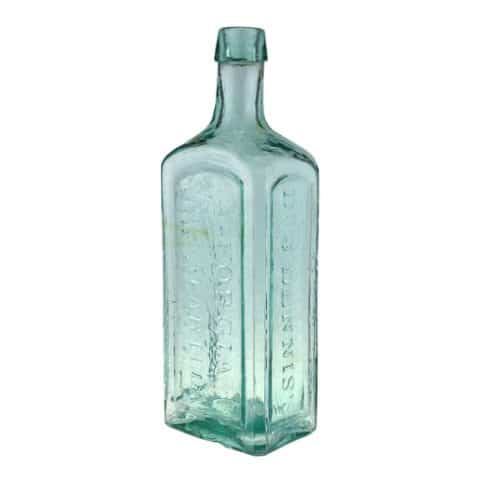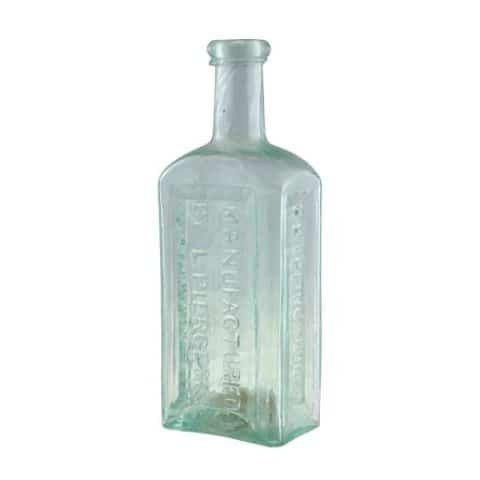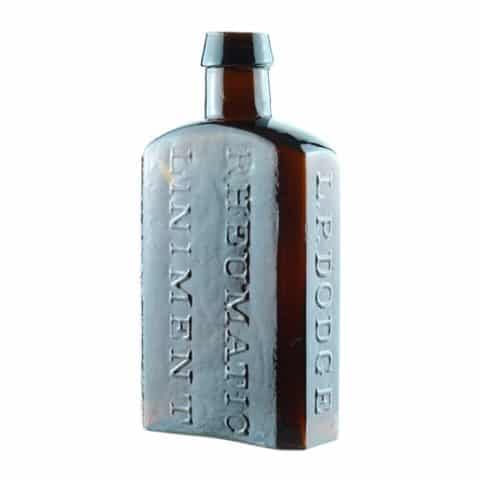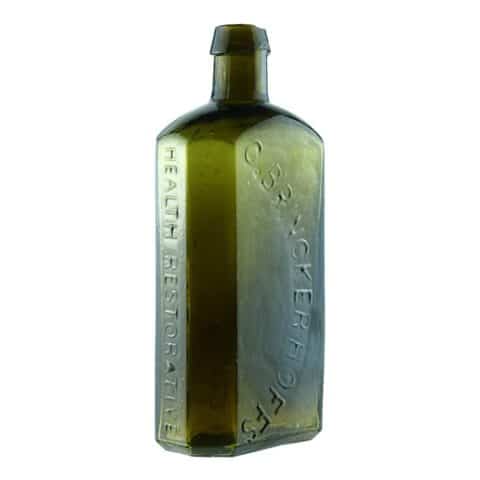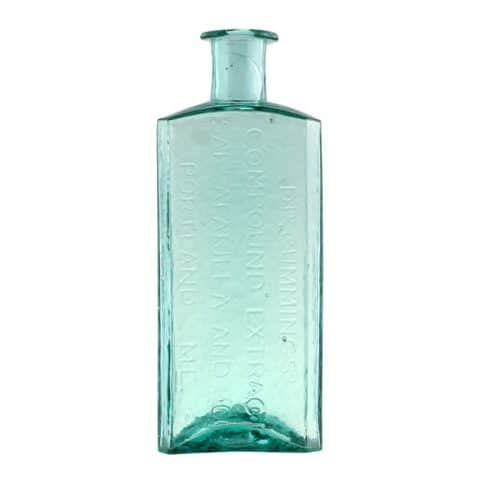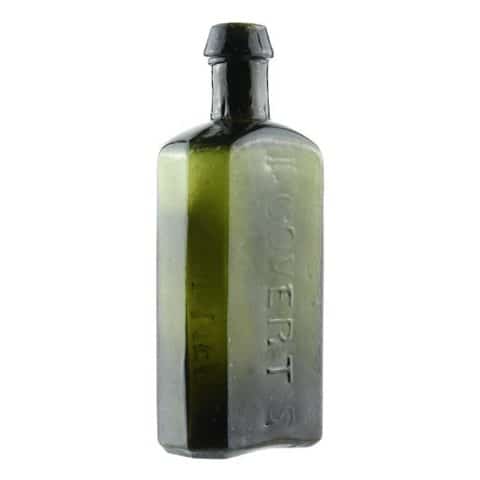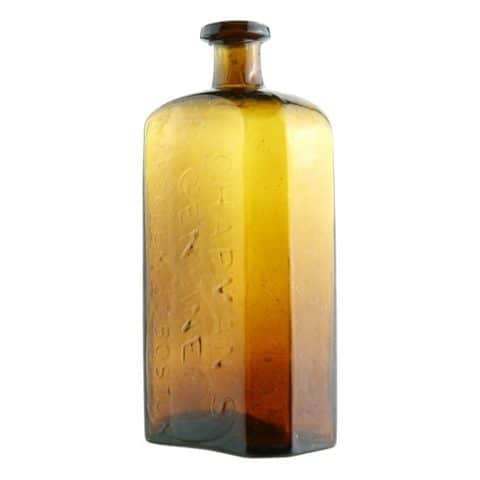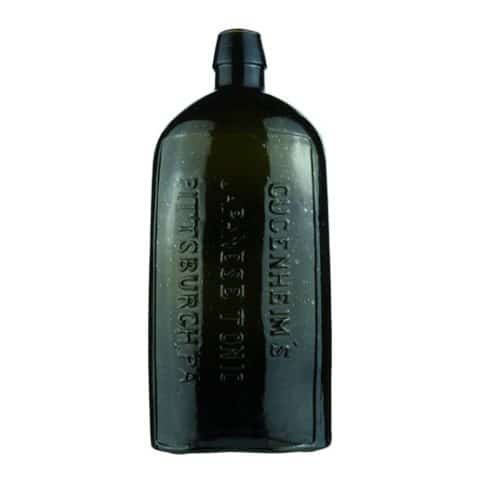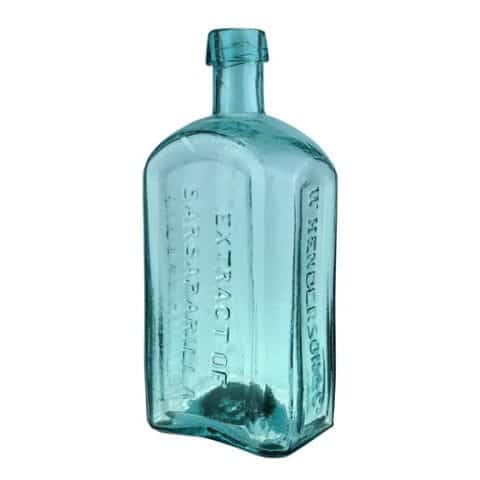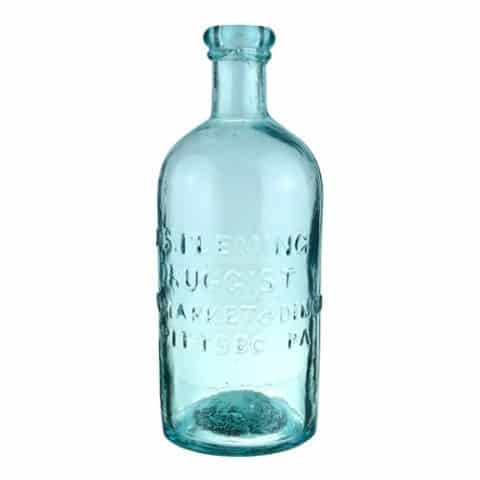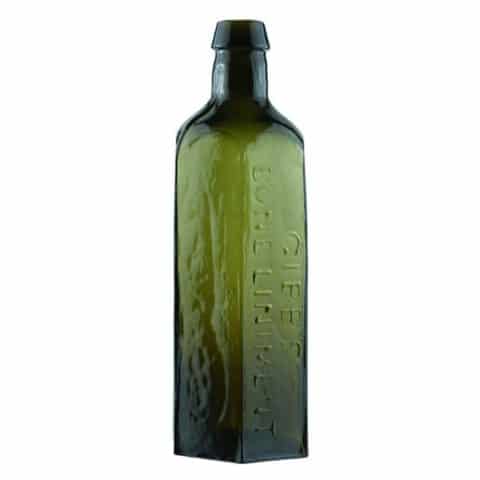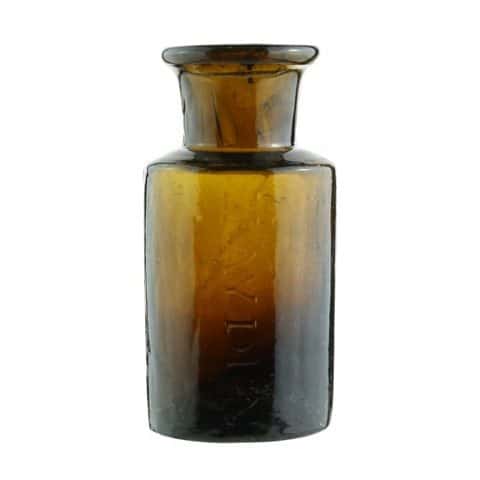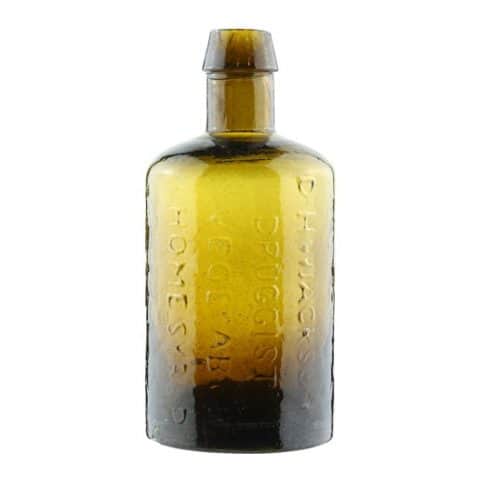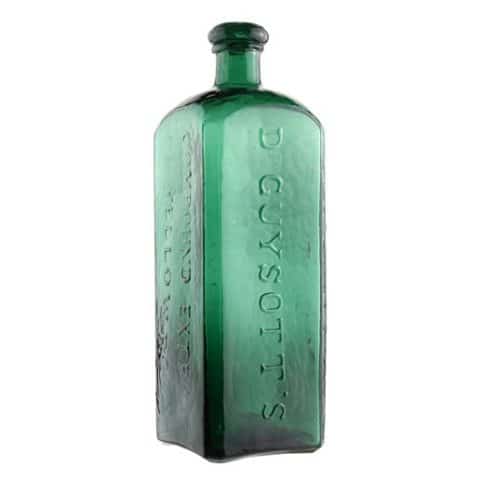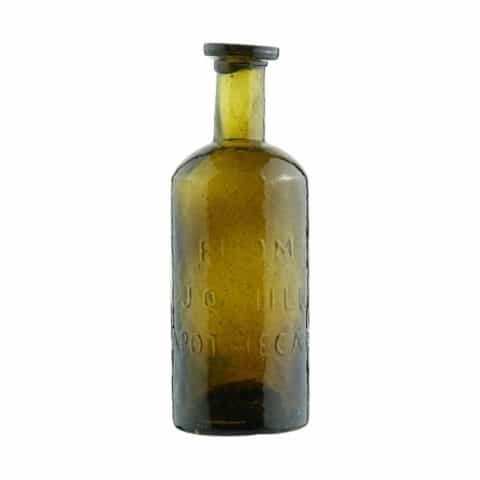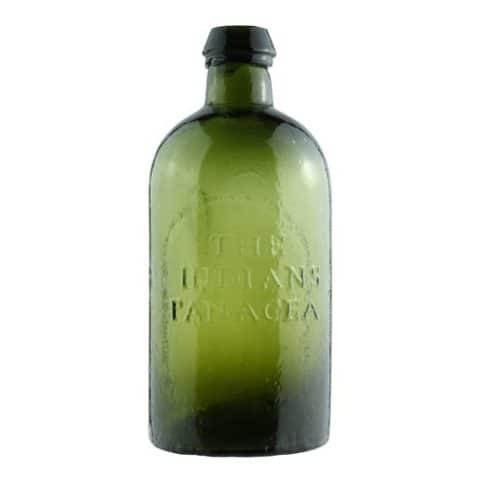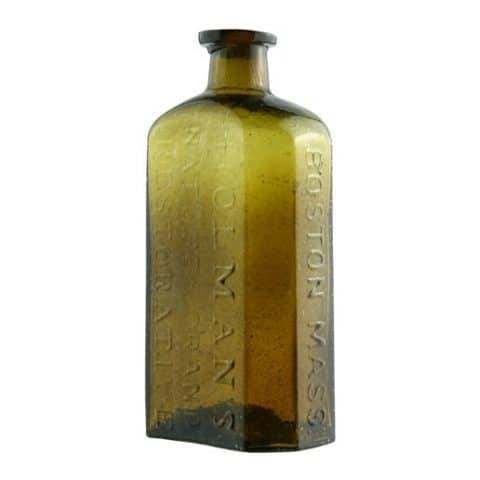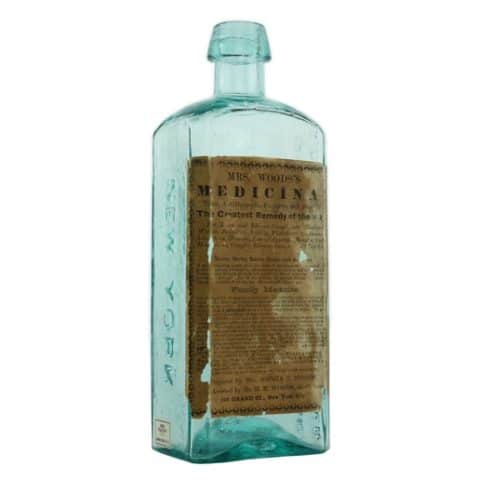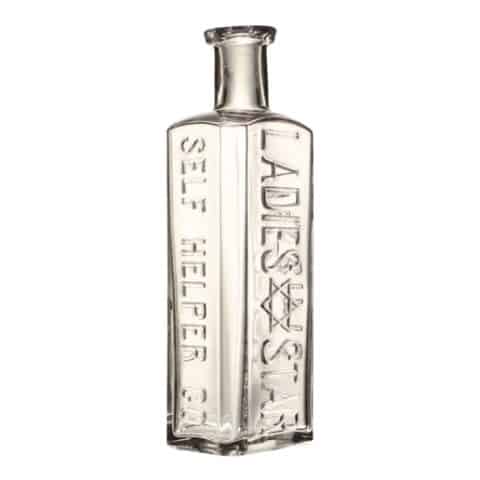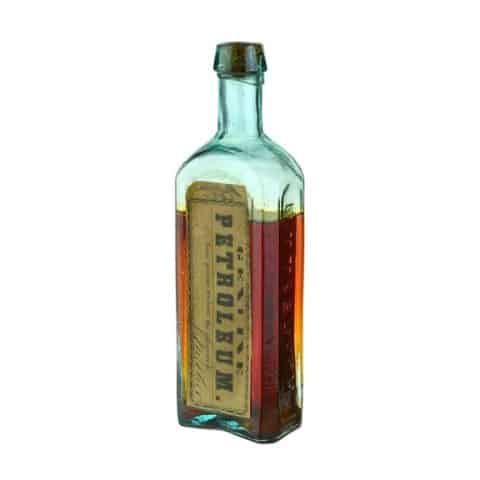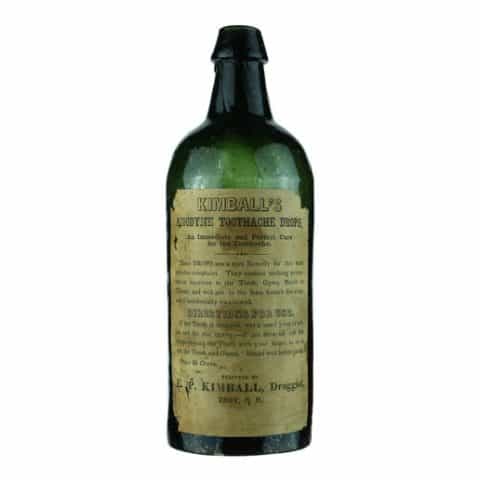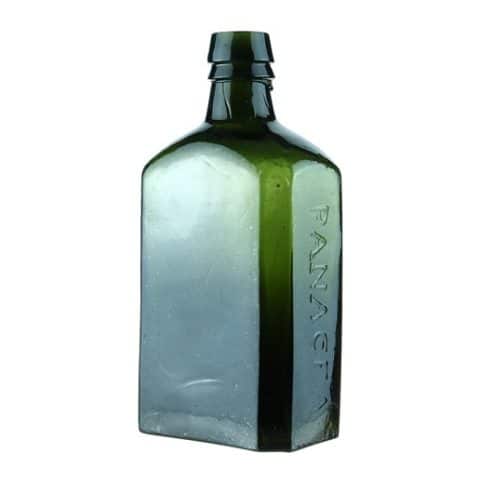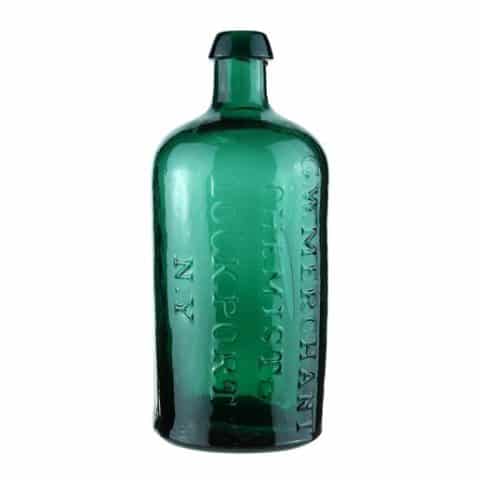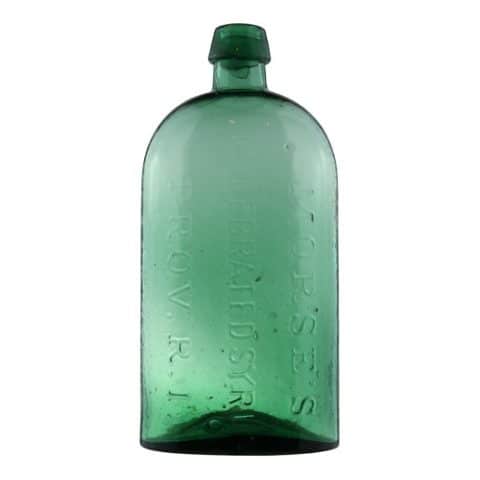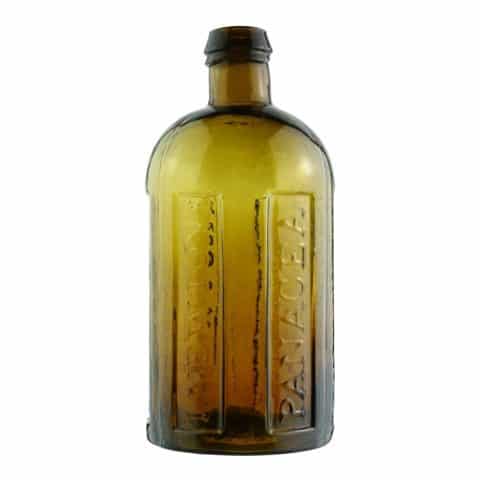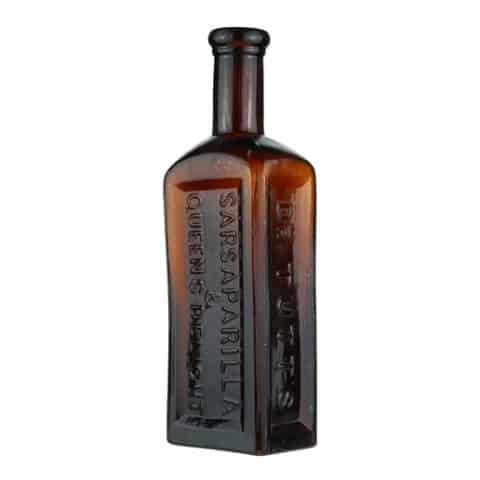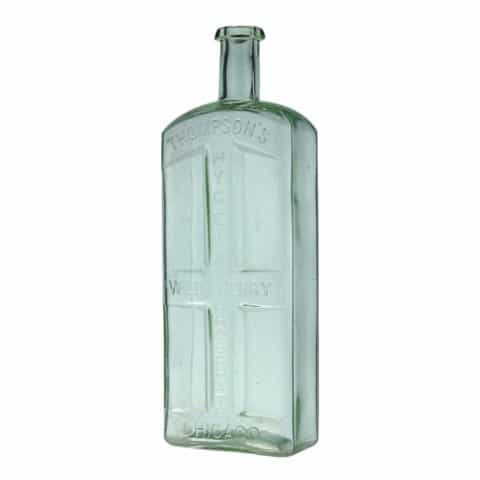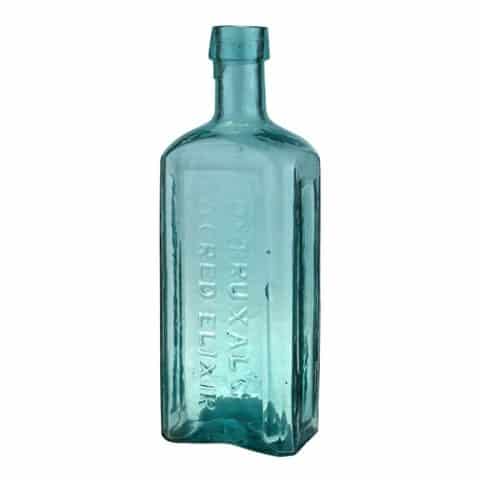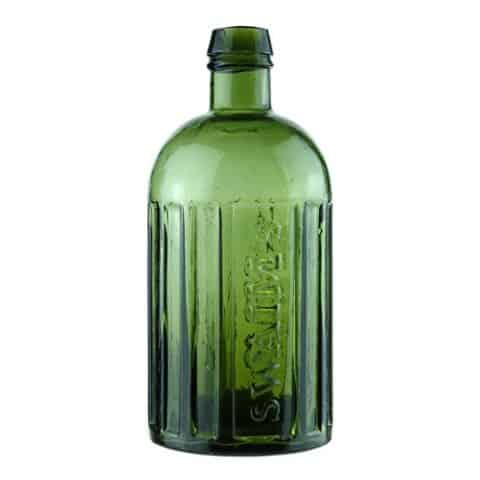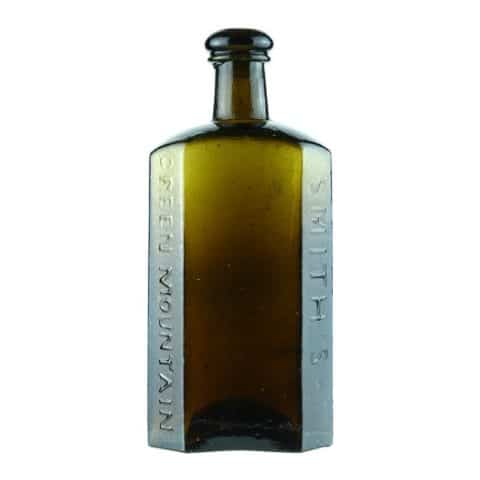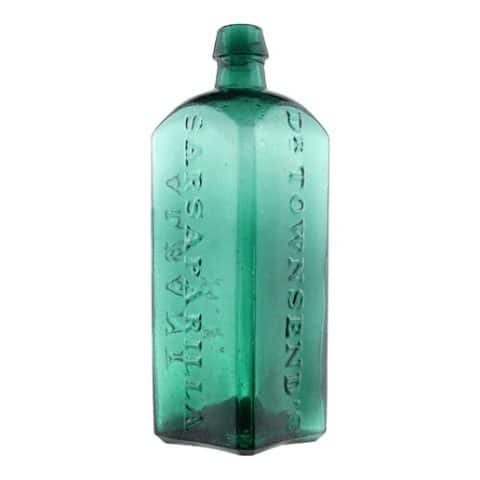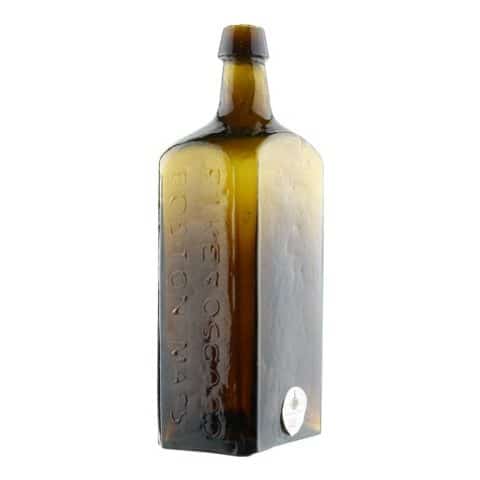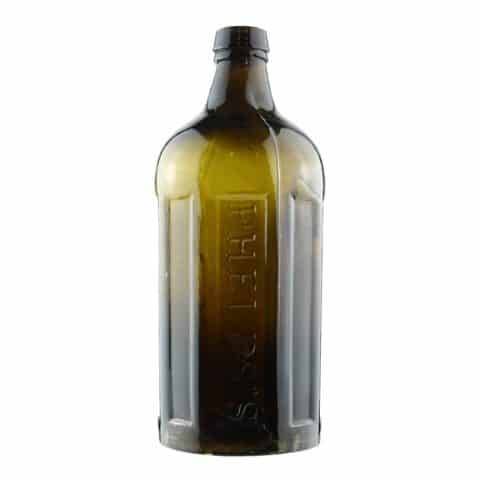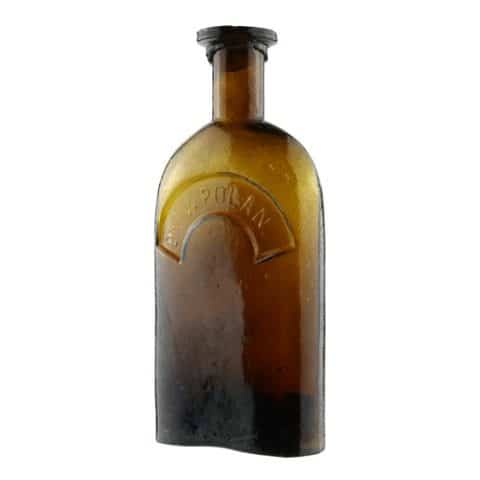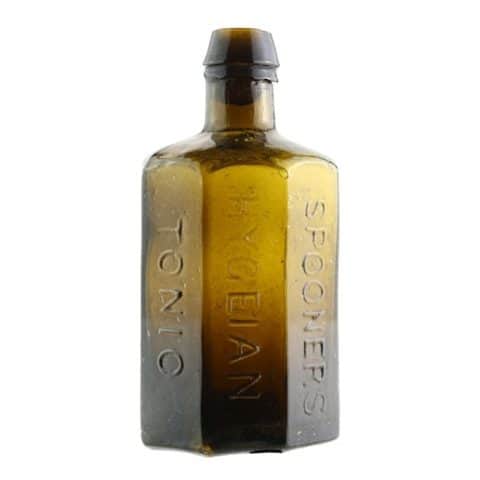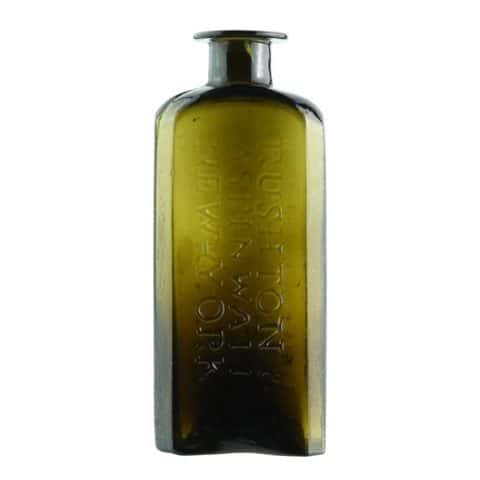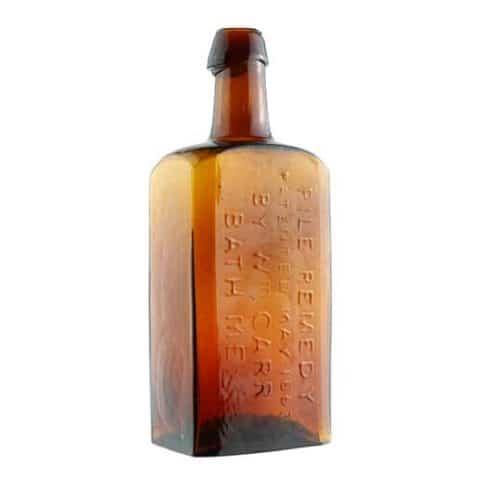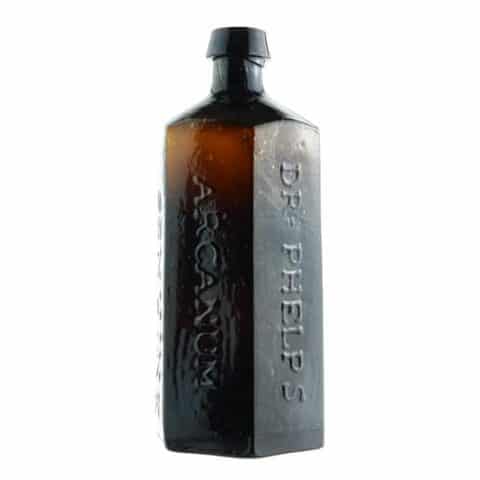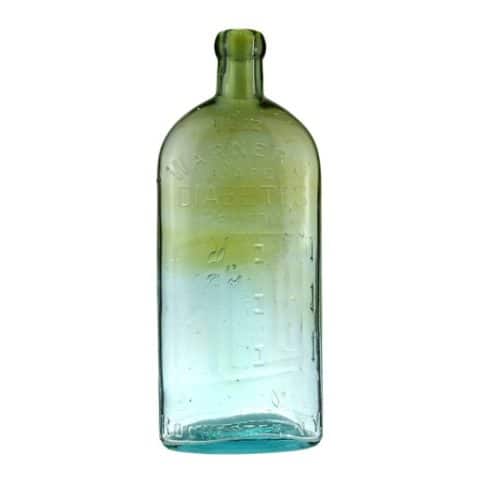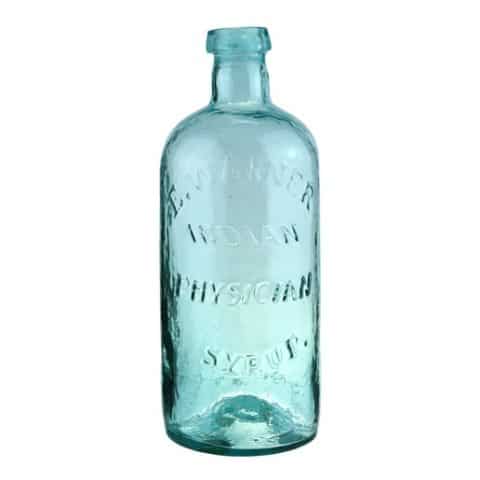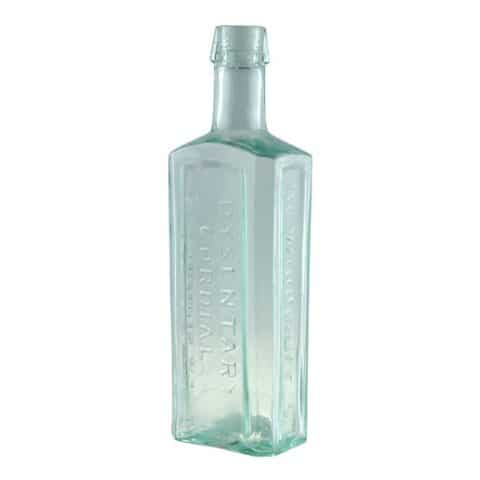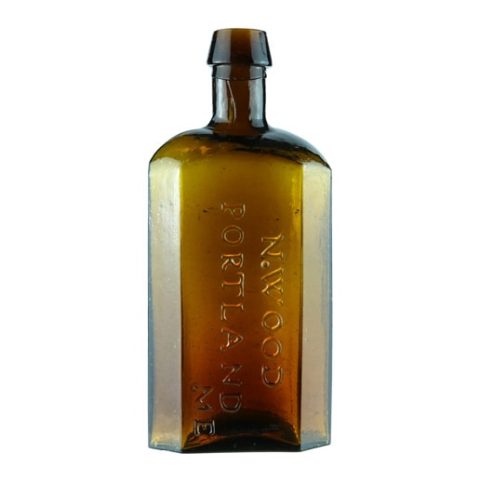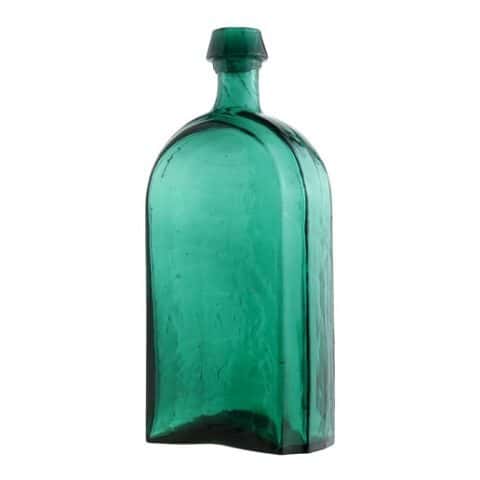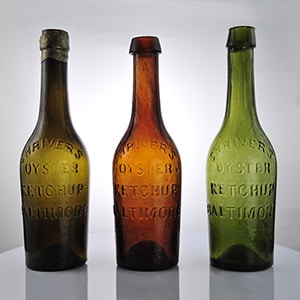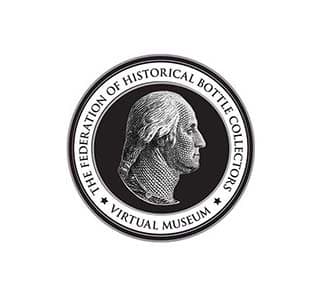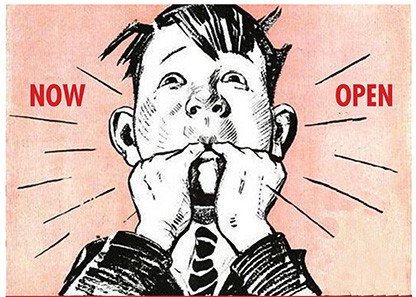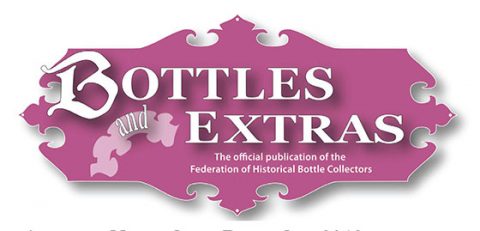Dr. Curless Blood Purifier Rheumatic Remedy San Francisco Cal.
Dr. Curless Blood Purifier
Rheumatic Remedy
San Francisco Cal.
Dr. William Curless, Truckee, California
Aquamarine Rectangular Medicine
Provenance: Eric McGuire Collection
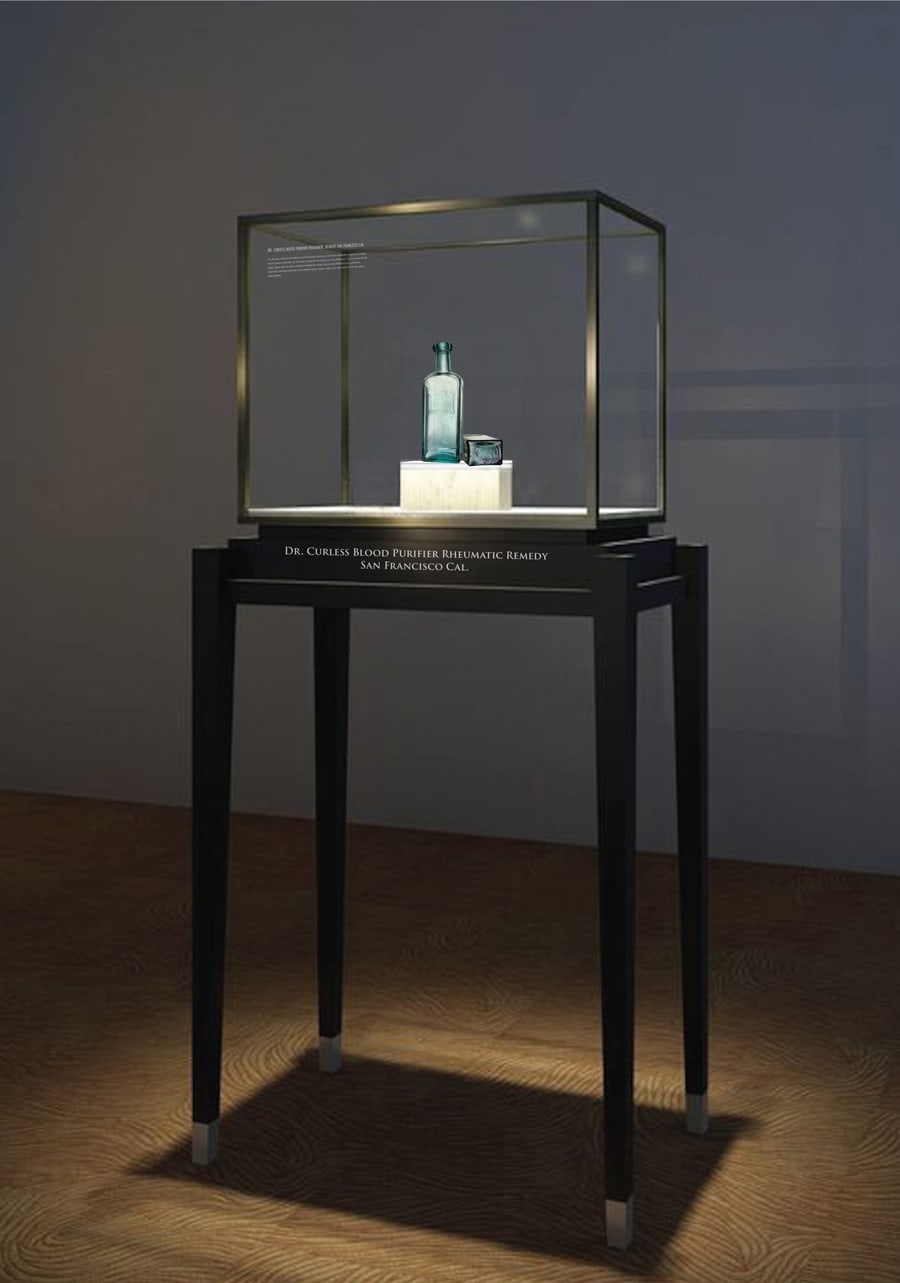
Dr. William Curless was a pioneer physician in Truckee, Nevada. He worked his way west from Ohio in the late 1840s, most likely searching for gold and a more prosperous life. How he became a “doctor” is unknown. Our Dr. Curless bottle is the only known example. It was acquired through a trade with another Western collector who obtained it from yet another Western collector who reportedly purchased it on eBay from a consignor in Florida.
The 7-¼ inch tall rectangular aquamarine bottle is embossed within all four recessed chamfered panels. The face has a recessed curved rectangular window with ‘DR CURLESS’ arched and embossed in two lines of sans serif copy within the form. The “R” in “Dr” is smaller and raised. The other three recessed panels read, ‘BLOOD PURIFIER’ (side panel 2), ‘RHEUMATIC REMEDY’ (side panel 3), and ‘SAN FRANCISCO, CAL.’ ( reverse panel). The base is smooth, and the bottle has a round applied collar with a beveled ring.

William Curless was born on January 23, 1822, in Clermont, Ohio. The 1850 United States Federal Census notes that he was 27 years old, farming, and had relocated to Jackson, Clinton, Indiana. He was the son of Wright S. and Rosanna Curless. His siblings were Henry, 21; John, 18; Biar, 16; Charles, 11; Wright, 8; Mahala, 2; and George, six months. In 1874, William Curless married Lois E. Hamilton Curless.
The 1860 census put William Curless in Hamilton, California, a former settlement in Butte County, the first permanent county seat. Hamilton is located on the west side of the Feather River, 15 miles downstream from Oroville. John Bidwell discovered gold there in 1848, and the settlement arose. The place was named Hamilton in honor of the nephew of Alexander Hamilton, who laid out the town.
By 1870, William Curless moved to Truckee, California and patented his medicine in 1871, and sold it in his new bottles made at a San Francisco glassworks. “Specification forming part of Letters Patent No. 117,870, dated August 8, 1871; antedated July 20, 1871. To all whom it may concern: Be it known that I, WILLIAM CURLESS, of Truckee, county of Nevada, State of California, have discovered a new and useful Medical Compound for the Treatment of Rheumatic Diseases; and I do hereby declare that the following is a full and complete disclosure of the name and quantity of each of the ingredients used, together with directions for making and using the same. My invention relates to a new and useful compound or medicine, which is particularly effective for treating rheumatic complaints. It consists of a simple mixture of the following ingredients, used in the proportions given, being calculated as the proper quantity to fill an eight (8) ounce bottle: Iodide of potassium, four (4) drams; biniodide of mercury, four (4) grains; extract of conium, (fluid,) two (2) drams; wine of colchicum-seed, two and one-half (2½) ounces; tincture of cinnamon, one and one-half (1½) ounce; simple syrup, four (4) ounces; aquae rubrum, four (4) drams. These ingredients are mixed together in the usual way, and for an adult one large table-spoonful is taken three times a day—once after each meal. This compound will be found an excellent remedy for all rheumatic complaints.”
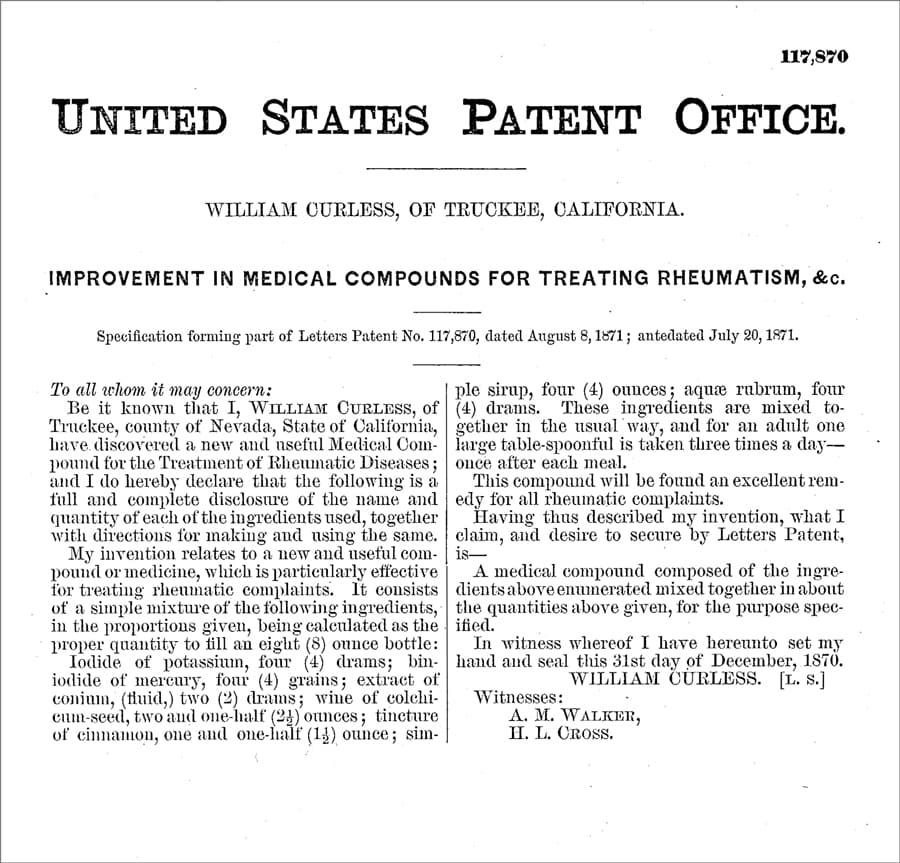
1871 was also about the time Wiliam Curless became “Dr. Curless” as his patent did not refer to him as one.
An 1872 notice in the Truckee Republican: “Blind and Destitute Indians. In company with Dr. Curless yesterday, we visited four blind and destitute Indians. They were located in a wigwam on the bluff immediately northwest of town. We found a buck, his wife and papoose, the latter about three years old, and one old Indian, apparently having seen four score years or more of life. All these Indians are blind from some ophthalmic disease, helpless, and forsaken by their own kith, kin and tribe. They said they had been in that condition for weeks, and for two days have had nothing to eat or drink. For the last few days some white people having found out their condition, gave them sufficient food and water. Dr. Curless gave them medicine and instructed them how to use it. The squaw was a kneeling posture, covered with rags, and weeping bitterly; The bucks seemed to take the matter very stoically, apparently indifferent whether they lived or died. It seems that when these Washoe Indians become helpless they are forsaken at once by their relatives and tribe and left to perish.”
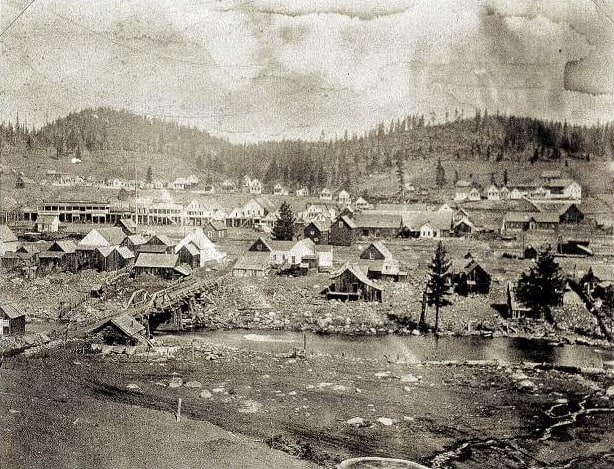
Truckee began in 1863 as Gray’s Station, named for Joseph Gray’s Roadhouse on the trans-Sierra wagon road. A blacksmith named Samuel S. Coburn was there almost from the beginning, and by 1866, the area was known as Coburn’s Station. Nevada would become the 36th state on October 31, 1864, after telegraphing the Constitution of Nevada to Congress days before the November 8 presidential election. The Central Pacific Railroad selected Truckee as the name of its railroad station by August 1867, even though the tracks would not reach the station until a year later, in 1868. The Chinese labor workers on Donner Summit were the literal muscle that constructed the CPRR and played an intrinsic role in propelling Truckee into becoming a lumber magnate from 1868 to 1878. It was renamed Truckee after a Paiute chief, whose assumed Paiute name was Tru-ki-zo.
The Donner Party ordeal is arguably Truckee’s most famous historical event. In 1846, a group of settlers from Illinois, known initially as the Donner-Reed Party but now usually referred to as the Donner Party, became snowbound in early fall because of several trail mishaps, poor decision-making, and an early onset of winter that year. Choosing multiple times to take shortcuts to save distance compared to the traditional Oregon Trail, coupled with infighting, a disastrous crossing of the Utah salt flats, and the attempt to use the pass near the Truckee River (now Donner Pass) all caused delays in their journey resulting in cannibalism as the travelers endured starvation. Of the original 87 settlers in the Donner-Reed party, 48 survived the ordeal.
The Truckee Weekly Tribune recorded on September 9, 1868, that Truckee contained “25 saloons, ten dry goods and clothing store, five grocery stores, seven lodging houses and sixteen’ china shops.'” Besides the local newspapers, the New York Tribune raved in 1869: “In feeding the steam engines on the railroad and hearths in Truckee, woodcutters were crucial and made up over 170 laborers who were paid $1.50/cord. Merchants and grocers owned 96% of the land in Chinatown and there were 11 grocery stores in town, such as Fong Lee’s store, and a gambling hall that was worth $8,000.”
Laundries were embedded in non-Chinese neighborhoods serving the greater community. Wau Lee’s laundry, south of the railroad tracks, offered a bathing house that many locals in town enjoyed. Four doctors, including Dr. Curless, practiced in Chinatown and were considered successful in treating venereal diseases. As the only female companionship in the male-dominated town, 22 prostitutes worked in eight houses adjacent to non-Chinese prostitutes.
Dr. William Curless would practice in Truckee for many years and serve as a druggist with his brother on Front Street. The Nevada Republican is peppered with accounts over the years when Dr. Curless was called to an accident or medical emergency.
1873: “One of the most shocking affairs that we have ever been called upon to relate occurred here on Saturday night. Doctor Curless was also called to the case without delay.” – Truckee Republican, September 30, 1873.
1873: “Thomas McDougall, who was engaged in hauling saw logs to the mill of the Nevada and California Lumber Company on Prosser Creek, was fatally injured on Thursday last. He was engaged in unloading logs at the mill from a pair of trucks when his left leg became entangled in the chain. Two logs rolled from the trucks at the same moment, striking and crushing his right shoulder and injuring his back and kidneys. The man was brought to town yesterday and placed under the care of Dr. Curless. The doctor informs us that McDougall’s injuries are fatal.” – Truckee Republican, September 27, 1873.
1876: “Fatal Accident in Truckee. About eleven o’clock this morning, Mrs. Mary Young, of this place, stopped at Mr. Davis’ store to settle a bill. She stopped sometime at the counter and conversed with Mr. Davis, after which she went to the counting-room and transacted her business, the counting room being at the rear end of the store, a distance of about 50 feet from the counter in front. After coming out of the counting house she came near a truck, which one of the hands in the store was wheeling. He told her to look out as she was standing near an open trap door, which led to a cellar. Just then, Mrs. Young made a step, and one foot went over the edge of the cellar way. She lost her balance and fell down the steps to the floor. She was immediately brought up and carried to the adjoining house, Caldwell’s Hotel when Dr. Curless was called. It was discovered that her neck was broken and her life extinct. Mrs. Young was born in Baltimore, in June, 1823. She came to California to visit her son, Mr. C. W. Young, in Nevada City in 1867. She returned East and remained there until one year ago when she again returned to California and settled in Truckee. Our fellow townsman, Mr. Charles Young, is her son. Mrs. Gobson, also residing here is here, is her daughter.” – Truckee Republican, October 3, 1873
1880: “Wm. Jones, proprietor of that famous pleasure resort, Soda Springs, died very suddenly at 6 o’clock Tuesday evening, at the Soda Spring Station, on the C. P. R. R. He was afflicted with pneumonia, and was only sick five days, and four of those days he was without medical attendance. Dr. Curless was called in when he was near his end but was unable to save him. – The Placer Herald, January 31, 1880.
1891: “Result of an Autopsy. It shows that Lanahan died of Alcoholism. An autopsy was performed this afternoon by Dr. Samuel McCurdy upon the body of Michael Lanahan. Dr. William Curless said a dozen other witnesses were present, including the attorney for McDougald. Lanahan died July 8, one month ago, presumably from wounds inflicted by Malcolm McDougald. At the examination before Justice Liggett the question arose as to whether Lanahan died from delirium tremens or from a blood clot on the brain, caused by a rupture of the meningeal artery. Dr. Curless treated Lanahan during the last 30 hours of his life for delirium tremens, and the autopsy fully sustains his theory.”
1892: “Truckee Makes a Kick. She Does Not Want to be a Cholera Refuge Station. Dr. William Curless is determined to fight any attempt to make Truckee a quarantine station against cholera. He is the legally appointed health officer, and his efforts will have great weight. He has written the State Board of Health and the railroad officials and emphatically protested against this town being made a place of refuge. He is a physician and surgeon for the railroad company and urges the potent reason that this is the end of a division and that all employees of both divisions would constantly exposed to contagion. He will take every precaution to keep the sanitary condition of the town perfect. He will forbid boys from entering the immigrant cars to sell coffee or to pass through them for curiosity as has been the custom. He advises that some point in Nevada be selected, away from centers of population, as a quarantine station for both states.” – Truckee Republican
Dr. William Curless died on January 26, 1898, in Truckee and rests in the Sierra Mountains Cemetery.
Primary Image: “Dr. Curless Blood Purifier” bottle imaged by Eric McGuire, FOHBC Virtual Museum West Coast Studio.
Join the FOHBC: The Virtual Museum is a project of the Federation of Historical Bottle Collectors (FOHBC). To become a member.

